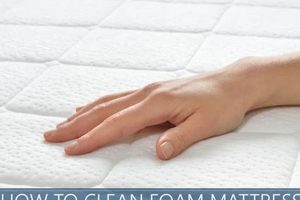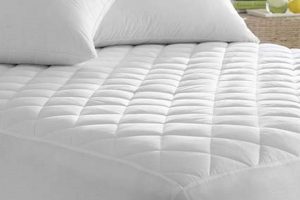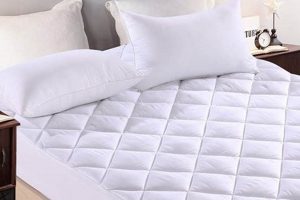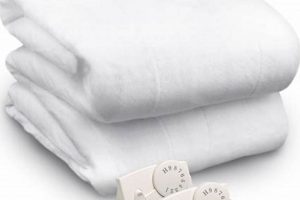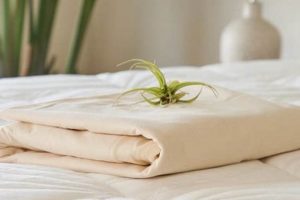A common inquiry among consumers seeking to enhance their sleep environment concerns the distinctions between a thin layer intended to protect the underlying sleep surface and a thicker layer designed to modify the feel of the bed. One is primarily for shielding the mattress from spills and stains, offering minimal change to the existing comfort level. The other aims to significantly alter the firmness or softness of the sleep surface, adding an extra layer of comfort or support.
Understanding these attributes is vital for selecting the appropriate product. Choosing wisely can prolong the life of the primary sleeping surface by preventing damage and wear. Furthermore, making an informed choice allows for customization of sleep comfort, potentially alleviating pressure points and improving overall rest quality. Historically, these items evolved from simple fabric coverings to sophisticated constructions using memory foam, latex, and other advanced materials.
The following sections will delve into the characteristics of each, outlining their respective features, benefits, and ideal usage scenarios. Details regarding materials, thickness, and intended function will be presented to facilitate a comprehensive comparison.
Guidance on Discriminating Between Sleep Surface Enhancements
Selecting the appropriate sleep surface enhancement requires careful consideration of individual needs and preferences. The following guidelines are designed to aid in differentiating between options and making an informed purchase decision.
Tip 1: Assess Thickness. Consider that a thinner profile typically indicates a protective function, while a greater depth often signifies a comfort-modifying purpose. A measurement under two inches usually implies the former.
Tip 2: Evaluate Material Composition. Analyze the construction materials. Protective layers are commonly made from cotton, polyester blends, or waterproof fabrics. Comfort layers frequently incorporate memory foam, latex, or down alternatives.
Tip 3: Define Intended Function. Clarify the primary goal. Is the objective to safeguard the underlying mattress from spills and stains, or to alter the feel of the sleeping surface?
Tip 4: Examine Attachment Mechanisms. Note how the layer attaches to the mattress. Protective models often utilize elastic straps or fitted skirts, while comfort models may simply rest on top due to their weight and density.
Tip 5: Consider Maintenance Requirements. Investigate cleaning and care instructions. Protective versions are typically easier to clean and maintain compared to more substantial comfort enhancements.
Tip 6: Analyze Budget Constraints. Establish a budget range. Protective options generally cost less than those designed to significantly alter sleep surface comfort.
Tip 7: Review Warranty Information. Scrutinize warranty terms. Warranty coverage can provide insights into the expected lifespan and quality of the product. A longer warranty period may indicate greater confidence in the product’s durability.
Adhering to these guidelines will aid in distinguishing between options and selecting the product that best aligns with individual needs and preferences, maximizing the investment and improving sleep quality.
The subsequent section will summarize the key differences and provide a concluding perspective on selecting the optimal choice.
1. Thickness
Thickness constitutes a primary differentiating factor. A significant variation in depth exists between mattress toppers and mattress pads, directly influencing their respective functions. Mattress toppers, characterized by a greater thickness, typically exceeding two inches, are designed to substantially alter the feel of the existing sleep surface. This increased depth allows for the incorporation of conforming materials such as memory foam or latex, which provide enhanced cushioning, pressure relief, and support. For instance, individuals seeking to soften a firm mattress might choose a memory foam topper with a three-inch profile.
In contrast, mattress pads are significantly thinner, often measuring less than one inch. Their primary purpose is to protect the underlying mattress from spills, stains, and general wear and tear, rather than to fundamentally change the sleep experience. The minimal thickness of mattress pads, frequently constructed from quilted cotton or polyester blends, offers a protective barrier without significantly impacting the firmness or contouring of the mattress. As an example, a waterproof mattress pad with a thickness of half an inch would primarily serve as a safeguard against liquid damage.
Consequently, the degree of thickness directly correlates with the intended function and resultant impact on sleep quality. While thinner pads offer protection, thicker toppers provide enhanced comfort and support. Understanding this fundamental difference is crucial for consumers seeking to optimize their sleep environment and extend the lifespan of their mattress.
2. Function
Function represents a critical point of divergence between mattress toppers and mattress pads, dictating their respective designs, materials, and ultimately, their impact on the sleep experience. The intended purpose determines the construction and properties of each item.
- Mattress Protection
One primary function is safeguarding the underlying mattress. Mattress pads are designed to shield the mattress from spills, stains, allergens, and general wear. For example, a quilted mattress pad with a waterproof membrane can prevent liquids from penetrating the mattress core, preserving its cleanliness and extending its lifespan. This protective function is particularly valuable for individuals with allergies or young children.
- Comfort Enhancement
Another key function involves modifying the comfort level of the sleep surface. Mattress toppers are specifically engineered to alter the firmness, support, or overall feel of the mattress. A memory foam topper, for instance, can conform to the body’s contours, relieving pressure points and promoting spinal alignment. Conversely, a latex topper may provide a firmer, more responsive surface. The function of comfort enhancement distinguishes toppers from pads, offering a customizable sleep experience.
- Temperature Regulation
Temperature management also falls under the umbrella of function. Certain mattress pads and toppers incorporate materials designed to regulate body temperature during sleep. Cooling gel-infused memory foam toppers, for example, can dissipate heat and prevent overheating. Similarly, mattress pads made from breathable fabrics, such as bamboo or cotton, can improve airflow and reduce moisture buildup. Temperature regulation as a function contributes to overall sleep
comfort. - Support and Alignment
Providing additional support and promoting proper spinal alignment is another functional consideration. While mattress pads offer minimal support, toppers can be engineered to enhance postural support. Toppers with zoned support, featuring varying densities of foam in different areas, can provide targeted support to specific regions of the body, such as the lumbar spine. This function is particularly beneficial for individuals with back pain or other musculoskeletal issues.
In summation, the function each product serves fundamentally distinguishes a mattress topper from a mattress pad. While the former focuses on protecting the integrity of the mattress, the latter is geared toward altering the comfort profile, managing temperature, and enhancing support. Recognizing these functional differences allows consumers to make informed decisions based on their specific needs and priorities.
3. Materials
Material composition is a defining characteristic when distinguishing between mattress toppers and mattress pads. The specific materials employed dictate the product’s performance, durability, and overall suitability for individual sleep preferences. A divergence in material selection reflects the differing functionalities of these bedding accessories.
- Core Materials for Toppers
Mattress toppers commonly utilize dense materials designed to alter the sleep surface’s feel. Memory foam, known for its conforming properties and pressure relief, is a prevalent choice. Latex, available in both natural and synthetic forms, offers a responsive and supportive alternative. Down and feather fills provide a softer, more plush experience. These core materials significantly impact the topper’s ability to contour to the body, regulate temperature, and provide targeted support, thereby transforming the overall sleeping experience. A memory foam topper, for example, would substantially soften a firm mattress.
- Core Materials for Pads
Mattress pads typically incorporate lighter, less dense materials focused on protecting the mattress. Cotton, polyester blends, and quilted fabrics are frequently used. These materials provide a barrier against spills, stains, and allergens without significantly altering the mattress’s firmness or contour. Some pads may include a thin layer of down alternative or wool for added comfort, but the primary emphasis remains on protection. A quilted cotton pad, for instance, primarily shields the mattress from wear and tear.
- Cover Fabrics
The cover fabric is another point of differentiation. Toppers often feature covers made from breathable materials like bamboo rayon or cotton to enhance airflow and prevent overheating. Some covers may incorporate moisture-wicking properties for added comfort. Pads, while also utilizing cotton or polyester blends, may prioritize water resistance or allergen protection in their cover fabric. The choice of cover fabric impacts the overall breathability and comfort of the product. A bamboo rayon cover, for example, can significantly improve the breathability of a memory foam topper.
- Construction Techniques
Construction techniques further contribute to the material-driven differences. Toppers frequently employ specialized construction methods, such as zoning or contouring, to provide targeted support to different areas of the body. Pads typically feature simpler quilting patterns designed to evenly distribute the fill material and prevent clumping. The construction technique directly influences the product’s durability and ability to maintain its shape and performance over time. A zoned topper, for instance, provides differentiated support to the lumbar and shoulder regions.
In summary, the materials used in mattress toppers and mattress pads reflect their distinct purposes. While toppers prioritize comfort modification through dense, specialized materials, pads focus on protection using lighter, more basic components. Understanding these material differences is crucial for consumers seeking to optimize their sleep environment and protect their mattress investment.
4. Attachment
The means by which a sleep surface enhancement affixes to a mattress is a defining characteristic that contributes to the distinction between a mattress topper and a mattress pad. Attachment mechanisms reflect the intended function and influence the overall stability and ease of use of each product.
- Elastic Straps and Fitted Skirts
Mattress pads frequently employ elastic straps or fitted skirts to secure them to the mattress. These attachment methods are designed for ease of use and removal, facilitating regular cleaning and maintenance. The elastic straps typically stretch around the corners of the mattress, while fitted skirts encase the entire mattress like a fitted sheet. This approach is suitable for thinner pads that primarily serve a protective function, as it provides a secure fit without significantly altering the mattress’s profile. For example, a waterproof mattress pad with elastic corner straps can be quickly attached and removed for laundering.
- Lack of Attachment Mechanisms
Mattress toppers, particularly those constructed from dense materials like memory foam or latex, often lack dedicated attachment mechanisms. The weight and density of these toppers, combined with their larger surface area, generally provide sufficient stability to prevent shifting during sleep. The absence of straps or skirts allows the topper to conform more closely to the body’s contours, maximizing its comfort-enhancing properties. However, this design can sometimes lead to slight movement, particularly on slick mattress surfaces. A five-pound memory foam topper, due to its inherent weight, typically remains in place without the need for additional attachment features.
- Integrated Attachment Systems
Some advanced mattress toppers incorporate integrated attachment systems designed to enhance stability and prevent slippage. These systems may include non-slip backing materials, adjustable straps, or even zippered connections to compatible mattress covers. Integrated attachment systems offer a compromise between the convenience of strap-free toppers and the security of elasticized pads. They are particularly beneficial for thicker toppers or those used on adjustable beds. A latex topper with a non-slip bottom surface will provide a more stable sleep environment.
- Impact on Sleep Experience
The method of attachment directly impacts the sleep experience. Securely attached mattress pads remain firmly in place, preventing bunching or shifting that could disrupt sleep. Conversely, toppers that are free from straps or skirts may provide a more seamless and comfortable feel, as there are no external elements to interfere with the body’s natural contours. The choice of attachment method depends on individual preferences for security versus comfort. A securely strapped mattress pad will minimize movement and noise during sleep.
In conclusion, the attachment method employed in mattress toppers and mattress pads reflects their differing functions and construction. While pads prioritize ease of use and security through elastic straps or fitted skirts, toppers often rely on their weight and density for stability, or incorporate integrated attac
hment systems for enhanced performance. The choice of attachment method should align with individual needs and preferences to optimize the sleep experience.
5. Cost
The cost associated with sleep surface enhancements represents a key differentiator, stemming directly from variations in materials, construction, and intended functionality. A mattress pad, designed primarily for protection, generally commands a lower price point due to its simpler construction and less expensive materials such as cotton or polyester blends. For example, a basic queen-size mattress pad may retail for under $50, reflecting its straightforward design and limited impact on sleep comfort. The relatively low cost makes mattress pads accessible to a wide range of consumers seeking to protect their mattress investment without significantly altering its feel.
In contrast, a mattress topper, engineered to modify the sleep surface and enhance comfort, typically incurs a higher cost. The use of premium materials, such as memory foam, latex, or down alternatives, contributes to the increased price. A queen-size memory foam topper, for instance, can easily exceed $200, reflecting the cost of the specialized materials and manufacturing processes involved. Additionally, toppers often feature advanced construction techniques, such as zoning or convoluted designs, which further elevate their price. This higher cost reflects the enhanced comfort, support, and potential for improved sleep quality that toppers offer.
The disparity in cost highlights the trade-offs between protection and comfort modification. While a mattress pad provides a cost-effective solution for safeguarding the mattress, a mattress topper represents a more significant investment aimed at improving the overall sleep experience. Consumers must carefully consider their budget and prioritize their needs to determine whether the added cost of a topper aligns with their desired level of comfort and support. Ultimately, understanding the cost implications is essential for making an informed decision regarding sleep surface enhancements.
Frequently Asked Questions
The following section addresses common inquiries regarding the distinctions between mattress toppers and mattress pads, providing clarity on their respective features and benefits.
Question 1: What defines the primary difference in purpose?
One serves principally to shield the underlying mattress from damage, whereas the other is intended to modify the comfort characteristics of the sleep surface.
Question 2: How does thickness differentiate the two?
A thinner profile is typically associated with protective function, while a greater depth suggests a comfort-altering function. Measurements are a key factor in assessing these attributes.
Question 3: What materials are commonly found in each?
Protective layers are frequently made from cotton or synthetic blends. Comfort layers often incorporate memory foam, latex, or down alternatives.
Question 4: How are they typically affixed to the mattress?
Protective models often utilize elastic straps or fitted skirts. Comfort models may simply rest on the mattress due to their weight and density.
Question 5: Which generally costs more?
Comfort-modifying versions typically represent a greater financial investment due to the premium materials and advanced construction techniques involved.
Question 6: How does maintenance differ between them?
Protective versions are generally easier to clean and maintain compared to more substantial comfort-enhancing versions.
Understanding these fundamental aspects facilitates informed purchasing decisions. Consider individual needs and prioritize desired outcomes to select the most appropriate product.
The subsequent section will provide a concluding overview, summarizing the key differences and offering guidance on choosing the optimal solution.
Difference Between Mattress Topper and Mattress Pad
This exploration into the difference between mattress topper and mattress pad has illuminated key distinctions in function, materials, thickness, attachment, and cost. Mattress pads, characterized by their thinner profile and simpler construction, serve primarily to protect the underlying mattress from spills, stains, and wear. Conversely, mattress toppers, typically thicker and crafted from specialized materials like memory foam or latex, are designed to modify the comfort and support characteristics of the sleep surface. The choice between these two options depends on individual needs and priorities, with protection being the primary goal for pad selection, and enhanced comfort driving the decision for a topper.
Ultimately, selecting the optimal sleep surface enhancement requires careful consideration of personal sleep preferences and budgetary constraints. By understanding the fundamental difference between mattress topper and mattress pad, consumers can make informed decisions that contribute to improved sleep quality and the prolonged lifespan of their mattress investment. Prioritizing needs and thoughtfully evaluating the features discussed herein will lead to a satisfactory and beneficial outcome.



